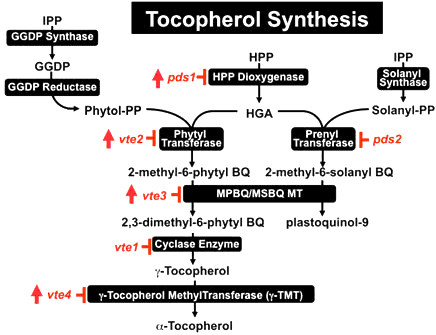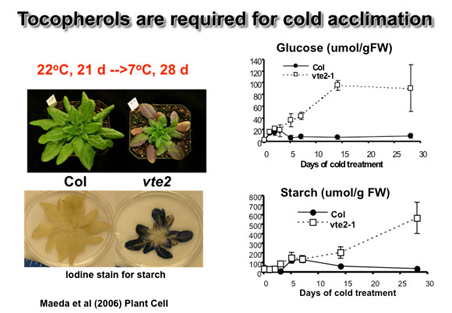Understanding Tocopherol Functions in Plants
 Understanding Tocopherol Functions in Plants
Understanding Tocopherol Functions in Plants
An outgrowth of our research has been the isolation of mutants in the tocopherol biosynthetic pathway in Arabidopsis and Synechocystis with which we could test long held assumptions about tocopherol functions in photosynthetic organisms. Surprisingly, the complete loss of this major lipid soluble antioxidant in chloroplasts had minimal impacts on the sensitivity of plants to high light, drought and salt stress; similar results were observed for the orthologous Synechocystis mutants. This overturned established dogma and indicated the role of tocopherols in stress tolerance is subtle or that other components of the antioxidant network can compensate for this deficiency. In contrast to photosynthetic tissues, we demonstrated tocopherols are absolutely essential for maintenance of seed viability and limiting lipid peroxidation during germination. In their absence massive lipid oxidation occurs during storage and germination resulting in high levels of lipid-derived signaling molecules that inappropriately activate defenses in the absence of pathogens. The severity of this seed phenotype explains the strong selection pressure that has maintained tocopherol synthesis in all extant seed plants.

Additional studies defined an unexpected role for tocopherols in adaptation of Arabidopsis to low temperatures. The response is cell-specific, resulting from deposition of callose at the plasma membrane of vascular parenchyma transfer cells, a single cell layer that surrounds the phloem and is essential for carbohydrate transport. This response does not involve alterations to photosynthesis, photoprotection or lipid oxidation although lipidomics showed the PUFA content of endomembrane lipids, but not plastid lipids, are dramatically altered. How deficiency of plastid-synthesized and localized tocopherols could strongly affect extra-plastidic lipid metabolism was puzzling. To address this issue recently completed suppressor screens identified two classes of strong suppressors: those that disrupt ER-localized fatty acid desaturation and those that affect a plastid envelop ABC transport system that moves lipids from the ER to the plastid. These data led us to hypothesize that plastid synthesized tocopherols directly interact with ER-localized enzymes and vice versa. Work on this topic is ongoing but has the potential to fundamentally change the way we view many aspects of plastid metabolism.